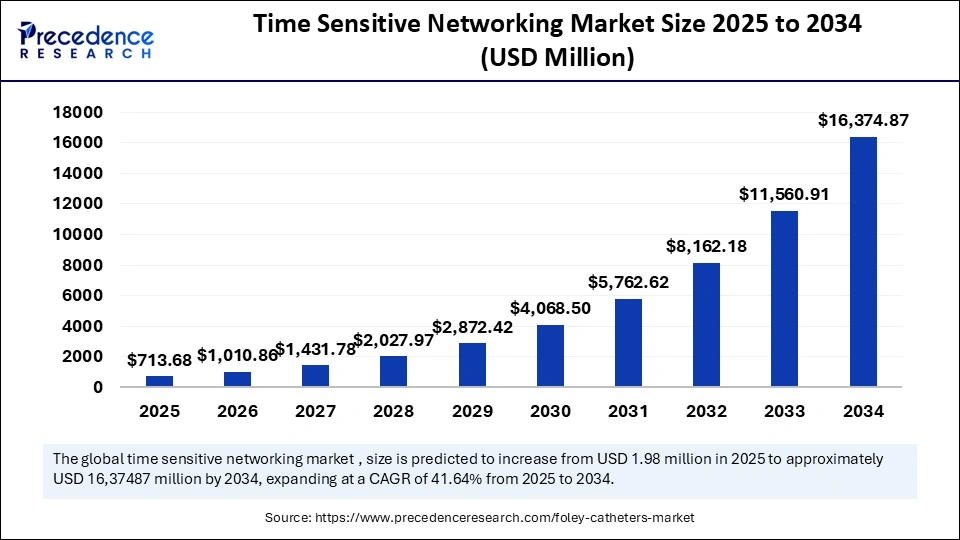The global Time Sensitive Networking (TSN) market was valued at USD 503.87 million in 2024 and is projected to soar to an impressive USD 16,374.87 million by 2034, registering a staggering CAGR of 41.64% over 2025-2034.

This explosive growth is fueled by the convergence of advanced Ethernet technologies, widespread Industry 4.0 adoption, and rapid deployment of 5G and edge computing networks, which together drive the demand for deterministic, low-latency communication systems essential for mission-critical applications.
Time Sensitive Networking Market Key Insights
-
The TSN market’s valuation grew from around USD 503.87 million in 2024 to USD 713.68 million in 2025.
-
Europe leads the global market with strong demand from Germany, France, and Nordic industrial automation hubs.
-
Key players dominating the TSN space include Texas Instruments, NXP Semiconductors, Siemens, Marvell, and Broadcom.
-
The industrial automation sector is the largest end-user, supported by automotive, aerospace, and telecom adoption.
-
The switch segment commands the largest revenue share within components due to its essential role in enabling synchronized Ethernet communication.
-
AI integration is enhancing real-time network optimization, predictive maintenance, and security for TSN systems, accelerating Industry 4.0 implementations.
What exactly is Time Sensitive Networking?
Time Sensitive Networking (TSN) is a suite of IEEE 802.1 Ethernet standards designed to ensure deterministic, time-synchronized, and highly reliable communication across networks, especially in industrial, automotive, aerospace, and telecom domains.
By enabling precise timing, traffic scheduling, and seamless handling of real-time and non-real-time data, TSN supports critical systems like autonomous vehicles, smart factories, and mission-critical infrastructures where timing accuracy and low latency are paramount.
How is AI reshaping the TSN landscape?
Artificial Intelligence is playing a transformative role in the TSN market by providing intelligent network analytics and automation capabilities. AI algorithms analyze network traffic in real time to predict congestion, guide resource allocation, and detect anomalies before they escalate.
This leads to enhanced security, predictive maintenance, and optimized performance, ensuring reliable communication for latency-sensitive applications such as autonomous systems and industrial automation. The synergy of TSN and AI fosters the widespread adoption of Industry 4.0 by enabling more efficient, scalable, and cost-effective networks.
What factors are fueling the immense growth of TSN?
-
Widespread Industry 4.0 adoption demands synchronized, deterministic Ethernet for converged IT/OT networks.
-
Expansion of autonomous and smart systems requires ultra-low latency and accurate timing.
-
Increasing investments in edge computing and 5G integration emphasize real-time monitoring and control.
-
Aging legacy systems are being replaced with unified TSN networks offering scalability and interoperability.
-
The rise of smart manufacturing, autonomous vehicles, and connected infrastructures drives TSN deployment globally.
Market Scope
| Report Coverage | Details |
| Market Size in 2024 | USD 503.87 Million |
| Market Size in 2025 | USD 713.68 Million |
| Market Size by 2034 | USD 16,374.87 Million |
| Market Growth Rate from 2025 to 2034 | CAGR of 41.64% |
| Dominating Region | Europe |
| Fastest Growing Region | Asia Pacific |
| Base Year | 2024 |
| Forecast Period | 2025 to 2034 |
| Segments Covered | Standard / Protocol Type, Component, Application, Industry Vertical, Deployment / Network Architecture, Service Offering, and Region |
| Regions Covered | North America, Europe, Asia-Pacific, Latin America, and Middle East & Africa |
What new opportunities and trends are emerging in the TSN market?
Is autonomous driving shaping the future of TSN?
Autonomous vehicles rely on TSN for precise, low-latency communication between sensors and control units, ensuring safety-critical data arrives on time for decision-making.
How is industrial automation evolving with TSN?
TSN enables smart factories to unify data flows from industrial equipment and IT systems, supporting synchronized robotic operations and real-time quality control.
Is the integration with 5G and edge computing significant?
The convergence of TSN with 5G networks and edge computers allows highly reliable, localized processing and communication, reducing delays and bandwidth usage.
What regional markets offer the most promise?
Europe remains a leader, driven by strong Industry 4.0 policies in Germany and the Nordics, but Asia Pacific is rapidly growing with increasing industrial digitization and manufacturing expansion.
Market Segmentation
-
By component, TSN switches dominate revenue due to their critical role in time-synchronized communication.
-
Standards such as IEEE 802.1AS (Timing and Synchronization) lead in adoption for ensuring accurate network timing.
-
Industrial automation leads applications, followed closely by automotive systems requiring real-time data exchange.
-
Regionally, Europe commands the market, with North America and Asia Pacific showing aggressive growth trends.
Latest Breakthroughs and Companies
Major players are driving innovation and market expansion through strategic launches and collaborations:
-
NXP Semiconductors launched the i.MX 94 family of application processors for industrial and automotive control.
-
Marvell introduced the Teralynx 10 Ethernet switch delivering ultra-low latency for data center and industrial applications.
-
Texas Instruments, Broadcom, Siemens, and others continuously expand their TSN portfolios emphasizing robustness and scalability.
Challenges and Cost Pressures
Despite rapid growth, TSN market faces challenges including:
-
High integration costs replacing legacy networks with TSN-compliant infrastructure.
-
Complexity in standardization and interoperability across multi-vendor environments.
-
Security risks requiring sophisticated AI-enabled protection mechanisms to prevent cyber threats.
Real-World Impact: A Case Study
An automotive manufacturer implemented TSN integrated with AI-based network analytics to synchronize communication between autonomous vehicle sensors and control systems. This resulted in a 30% reduction in latency, significantly improving vehicle safety and operational efficiency while reducing downtime via predictive maintenance.
Read Also: Gate-All-Around (GAA) Transistor Market
You can place an order or ask any questions. Please feel free to contact us at sales@precedenceresearch.com |+1 804 441 9344